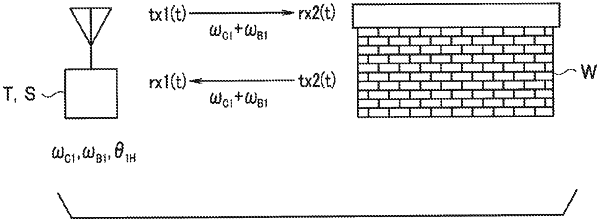| CPC G01S 7/4912 (2013.01) [G01S 13/36 (2013.01); G01S 13/84 (2013.01); G01S 17/32 (2013.01); G01S 13/38 (2013.01)] | 4 Claims |

|
1. A distance measuring device that calculates a distance between a first device and a second device, at least one of which is movable, on a basis of phases of first to sixth known signals transmitted with a plurality of carrier frequencies, the distance measuring device comprising:
the first device including
a first reference signal source, and
a first transceiver configured to transmit the first known signal corresponding to a first carrier frequency, the second known signal corresponding to a second carrier frequency different from the first carrier frequency, and the third known signal corresponding to a third carrier frequency different from the first and second carrier frequencies, and to receive the fourth known signal corresponding to the first carrier frequency, the fifth known signal corresponding to the second carrier frequency, and the sixth known signal corresponding to the third carrier frequency, using an output of the first reference signal source;
the second device including
a second reference signal source configured to operate independently from the first reference signal source, and
a second transceiver configured to transmit the fourth known signal corresponding to the first carrier frequency, the fifth known signal corresponding to the second carrier frequency, and the sixth known signal corresponding to the third carrier frequency, and to receive the first to third known signals, using an output of the second reference signal source;
a first phase detector provided in the first or second device, the first phase detector being configured to detect phases of the fourth and fifth known signals received by the first transceiver;
a second detector provided in the first or second device, the second detector being configured to detect phases of the first and second known signals received by the second transceiver; and
a calculating section provided in the first or second device, the calculating section being configured to calculate the distance between the first device and the second device, wherein
the first transceiver and the second transceiver perform a total of five times of transmissions and receptions including four times of transmissions and receptions including a plurality of times of transmissions and receptions of at least one of the first, second, fourth, or fifth known signals, and a single time of transmission and reception of at least one of the third or sixth known signals,
at least one of the first phase detector or the second phase detector detects a phase with respect to the first, second, fourth, and fifth known signals,
the calculating section calculates the distance between the first device and the second device by offsetting a frequency difference between the first known signal and fourth known signal and a frequency difference between the second known signal and the fifth known signal by an operation including a difference operation of the phases, and
the calculating section corrects the calculated distance on a basis of an amplitude ratio with respect to the third known signal or the sixth known signal.
|